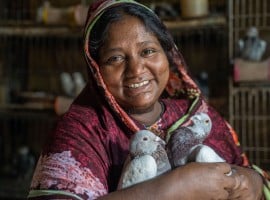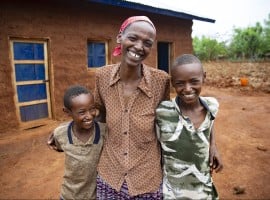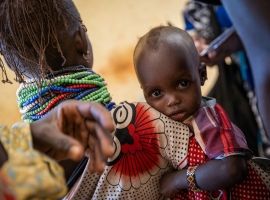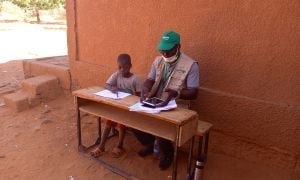
Read our 2024 annual report

Knowledge Hub

Safe Learning Model
Overview
School Related Gender Based Violence (SRGBV) has been identified as a major barrier to children accessing their right to safe, quality education, and is an unfortunate reality for many children in the countries that Concern operates education programming.
SRGBV prevention and response mechanisms are embedded in all Concern education programmes, and we are committed to the development of models of best practice and lessons learned from SRGBV programmes.
What is the Safe Learning Model?
The Safe Learning Model adopted a holistic approach to education that brings together transformative gender interventions within an education programme. The model, piloted and evaluated in Sierra Leone 2017-2021, is based on evidence that children’s educational progress is enhanced when they live in communities that are underpinned by support for gender equality and children’s wellbeing. This three-level approach to learning addresses access, quality and wellbeing by countering the issues of SRGBV and gender stereotypes, which can keep children from learning or cause them to drop out of school.
The combined interventions aim to improve foundational learning outcomes and primary school attendance, as well as increase the protection and wellbeing of children. The model consists of three core components:
School Level SRGBV Prevention and Response
School level SRGBV interventions utilise a transformative approach to address the different aspects of SRGBV, covering prevention and response programming, incorporating health, education, protection and gender initiatives with primary students and teachers. Activities should be built into existing education systems where possible and includeD:
- School Clubs targeting upper-primary students. A contextualised curriculum, conducted in mixed and single sex groups depending on the topic, aimed to reduce the impacts of SRGBV by supporting early adolescents to develop knowledge and skills to be successful and protected from violence and abuse.
- Social and Emotional Learning (SEL) sessions for lower-primary students. A contextualised programme of structured play activities for the most vulnerable young children based on five SEL competencies (Brain Building, Emotion Regulation, Positive Social Skills, Conflict Resolution and Perseverance).
- Teachers, head-teachers, and SMC training on school administration and gender norms in the classroom, the Code of Conduct and referral pathways based on the gender transformative approach.
- SRGBV response and referral pathways and preventative messaging reflective of the gender transformative approach.
Community Level SRGBV Prevention and Response
Comprehensive Literacy Interventions including competency based Continuous Teacher Professional Development

These three components are designed to work together to address the three core outcomes:
- 1
Boys and girls have increased access to education.
- 2
Boys and girls demonstrate improved quality Learning Outcomes.
- 3
Boys and girls have improved wellbeing and gender equality.


Research and Learning
In addition to the interventions, the Safe Learning Model included a research component aimed at testing whether the different elements of the activities work and how the different levels interact. This research tested the hypothesis that children will learn better if they are in a safe environment protected from SRGBV.
The working assumption behind the programme was that children’s educational progress will be enhanced when they live in communities where there is more support for gender equality and children’s wellbeing.

UCD research and results
The responsibility for the research was allocated to the University College Dublin (UCD) School of Education. The research institute was engaged in a five-year partnership with Concern and worked with national-level research partners NestBuilders International for data collection and to ensure local expertise was embedded in all stages of design, study, and dissemination.
The study was divided into two phases: a pilot phase in the first year (2017-2018) and the main trail from 2018 to 2021. The pilot phase allowed Concern, in partnership with MEST to develop effective methods of delivering the Safe Learning Model as a comprehensive programme to scale up the interventions in phase 2. The pilot, carried out in 10 communities (5 interventions and 5 control) also enabled UCD School of Education, working in partnership with Concern and NestBuilders, to develop research tools for evaluating the Safe Learning Model in the main trial, which was being carried out in 100 communities.
Schools were eligible for the main trial based on the following criteria:
- They were within the selected chiefdoms of Tonkolili District;
- They had classes 1-6 (meaning junior primary schools with only classes 1-3 were excluded).
- They had sufficient enrolment numbers (>15 children in class 3 and on average at least 10 children in classes 4- 6), based on enrolment data collected by Concern Sierra Leone staff between March and May 2017.
- Where communities had more than one primary school, one school was selected to participate based on criteria of being an unapproved school with at least one teacher on payroll. If multiple schools in the one community met these criteria, the school with the middle enrolment size was selected.
The participants (around 100 per community) included primary school teachers, pupils, and community members who have agreed to participate in the study. To measure the efficiency of the various levels of activities, the communities of the main trail were allocated to four groups of 25 using a simple stratification process.


Baseline Results
The main trial of Concern’s Safe Learning Model intervention was being evaluated by University College Dublin (UCD) School of Education and involved tracking the same children (and their communities clustered into four groups of tiered level of intervention) over three academic years.
In September 2018, the baseline was conducted with over 3,000 children as they entered their first year of primary education in the 100 schools taking part in the randomised control trial. The mixed methods approach includes the administration of structured questionnaires and assessing children’s literacy levels using an Early Grade Reading Assessment (EGRA) with all children each year of the intervention, along with interviews of their teachers and head teachers (100). The study also includes an in-depth exploration of four case study communities (drawn from the four arms of the trial) to include Class 1 children, their teachers, headteachers and a selected subsample of 16 children and their extended families (parents and elders / grandparents).
Findings
- Most Class 1 children engage in domestic work with evidence of gender labour division.
- There are differences in expectations for schooling for girls and boys, with lower expectations for girls.
- Girls have lower expectations for their own ‘brilliance’.
- About 70% of respondents (boys and girls) are whipped or caned regularly by parents and teachers.
- Despite the levels of corporal punishment, an overwhelming majority of teachers identified schools as spaces where both boys and girls are ‘very safe’ or ‘somewhat safe’ (e.g. free from bullying, intimidation, physical violence, etc. in school or on the way to school).

Year One Results
In May 2019, post-test one was conducted with the approximately 3,000 children taking part in the randomised control trial as they finished their first year of primary education in the 100 schools in Tonkolili Sierra Leone. The quantitative and qualitative data collected provides further insight into the children’s lived experiences both in and outside of school. As the study took place over a number of years, and in order to maintain research integrity, results directly related to the effectiveness of each level of the model were not released until the conclusion of the. However, over the first year of intervention, evidence emerged of small but statistically significant changes in literacy and wellbeing outcomes among the study population.
Findings
- Higher increases in average child wellbeing in intervention compared to control schools, with increases significantly higher among girls than boys.
- Significant decrease in EGRA zero scores (baseline of 45% decreased to 26% after one year) with no significant gender differences, but significantly higher improvements in intervention schools for some tasks.
- Significant, substantial increase in proportion of children reporting domestic chores, or work outside the home, but this did not reduce play time.
- Girls tend to do domestic chores more frequently than boys, but both boys and girls experienced a similar increase in this work.
- 56% of the children reported being whipped or caned by their teachers and about 59% by their parents.
- A higher proportion of boys were whipped or caned by teachers and girls by their families, but gender differences were not significant.
- Fewer incidences of direct violence (physical and psychological violence) reported between baseline and post-test 1. Lower average level of direct violence in intervention compared to control, but differences were not significant.
- Children’s perception of positive attitudes toward gender equality among teachers increased, but among family decreased from baseline to post-test 1.
In schools that teachers considered as very safe for pupils, children perceived a higher level of positive gender equality attitudes from teachers in comparison to schools not considered as very safe.

Covid-19 Sub Study Results
Within the overall Safe Learning Model research framework, a sub-study was conducted on the impacts of COVID-19 on schools, children and their learning. COVID-19 had significant impacts on all sectors of social, economic and political life in almost all countries of the world, with schools in Sierra Leone officially closed on 31st of March 2020.
This sub-study provides information on the implementation of school closures in Tonkolili district and on the immediate and perceived impact on children, teachers and school principals. The sub-study utilised a mixed method approach including quantitative structured interviews with head teachers from 77 of the 100 schools participating in the main Safe Learning Model study and qualitative semi-structured in-depth interviews with four head teachers of schools that are part of the in-depth case studies for the wider Safe Learning Model study. The data collected for this sub-study has the potential to map the impact of the school closures in the context of the Safe Learning Model with a view to informing subsequent analysis of both the ‘moment in time’ impact and the impact over the duration of the implementation of the Safe Learning Model intervention.
Findings
- Schools were ‘a little prepared’ or ‘not prepared’ for closures.
- Perception of little communication or Government support.
- Closures have had a negative impact on learning outcomes.
- Schools receiving support for continued learning more likely to stay in contact with pupils and engage in small learning groups.
- Schools with higher results prior to closures more likely to engage students in continued learning, widening gap in learning.
- Most children not utilising the radio programme but are more likely to use it when engaged in learning groups with teachers.
- Children in hard-to-reach areas excluded from learning activities.
- Few pupils are engaged in learning with their family.
- Boys and girls are engaging in increased work, with girls disproportionately affected and exposed to protection risks.

Final Results
In November 2020, and May 2021 post-tests two and three of the three-year longitudinal study with approximately 3,000 children, their teachers, and caregivers from 100 primary schools in Tonkolili, Sierra Leone were conducted.
The randomised control trial conducted over a three-year period utilised a mixed methods design that included; 376 semi-structured interviews and group discussions along with participatory approaches such as photo voice, 42 hours of classroom observational data, analysis of school records, annual Early Grade Reading Assessments (EGRA) and the Child and Adolescent Personal and Social Assessment of Wellbeing (CAPSAW).
The study examined wellbeing, gender equality, experiences of school related gender-based violence and literacy development of a cohort of pupils and their everyday experiences in school and at home including examining the bidirectional relationship between literacy, wellbeing and safety and ultimately how this may be affected by the programme.
Findings
- The Safe Learning Model had positive impacts on basic Literacy skills and wellbeing, especially for girls, despite significant challenges of endemic poverty, gender stereotypes, structural problems of the educational system and the impact of school closures during the COVID-19 pandemic.
- There is a clear link between Literacy progress and Wellbeing, particularly for girls.
- Overall, improvements in Literacy were present for both boys and girls over time.
- Literacy skills of children in the Safe Learning Model, in particular girls, generally improve more quickly than children not receiving the intervention.
- On average, boys perform better than girls across subtasks, but girls in the Safe Learning Model progress faster, closing the gender gap.
- There were no differences in teaching practices of qualified and unqualified teachers.
- Teachers in the Safe Learning Model identify letter sounds as important and spend significant time teaching this, which was reflected in children’s improved basic Literacy skills at an earlier stage.
- Teachers, principals, and caregivers have high aspirations for the education of girls and believe it is necessary but have lower expectations for their success in school with the majority believing boys are more brilliant than girls.
- Children’s psychological wellbeing, specifically ‘feeling good’ declined during COVID-19, however girls receiving the Literacy component of the Safe Learning Model show significant increases in ‘feeling good’ at the end of the intervention.
- Children that feel safer with a teacher are more likely to report having been whipped or caned by a teacher.

External Publications
- UCD Impact Case Study: Safe Learning: improving girls' literacy and wellbeing in the Global South
- UCD Project Website: The Safe Learning Study
- Government of Sierra Leone, Ministry of Basic and Senior Secondary Education Transforming Education Service Delivery Through Evidence-Informed Policy and Practice Volume 1
Partner Organisations
This research was undertaken by University College Dublin- School of Education on the Safe Learning Model and implemented by Concern Worldwide in partnership with the Sierra Leone Ministry of Basic and Senior Secondary Education (MBSSE). The Safe Learning Model intervention and research was funded by a grant from the Irish Government, however the content within this publication is entirely the responsibility of the authors and does not necessarily represent or reflect Irish Aid Policy.




